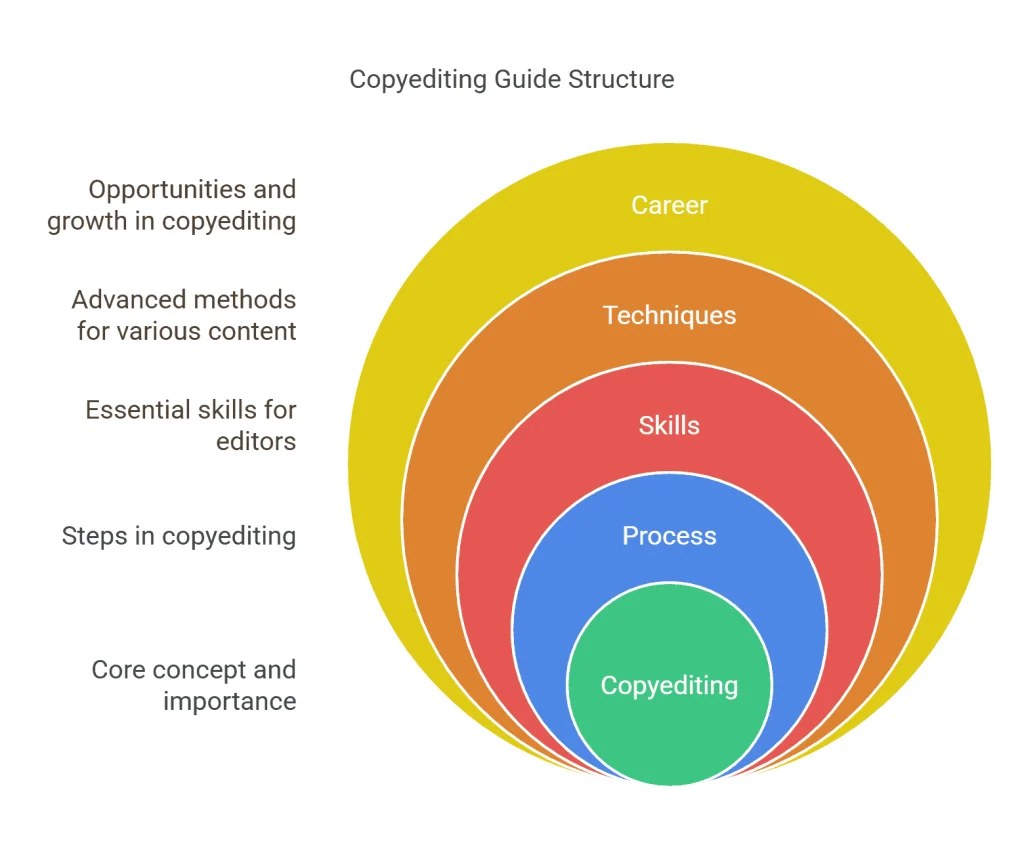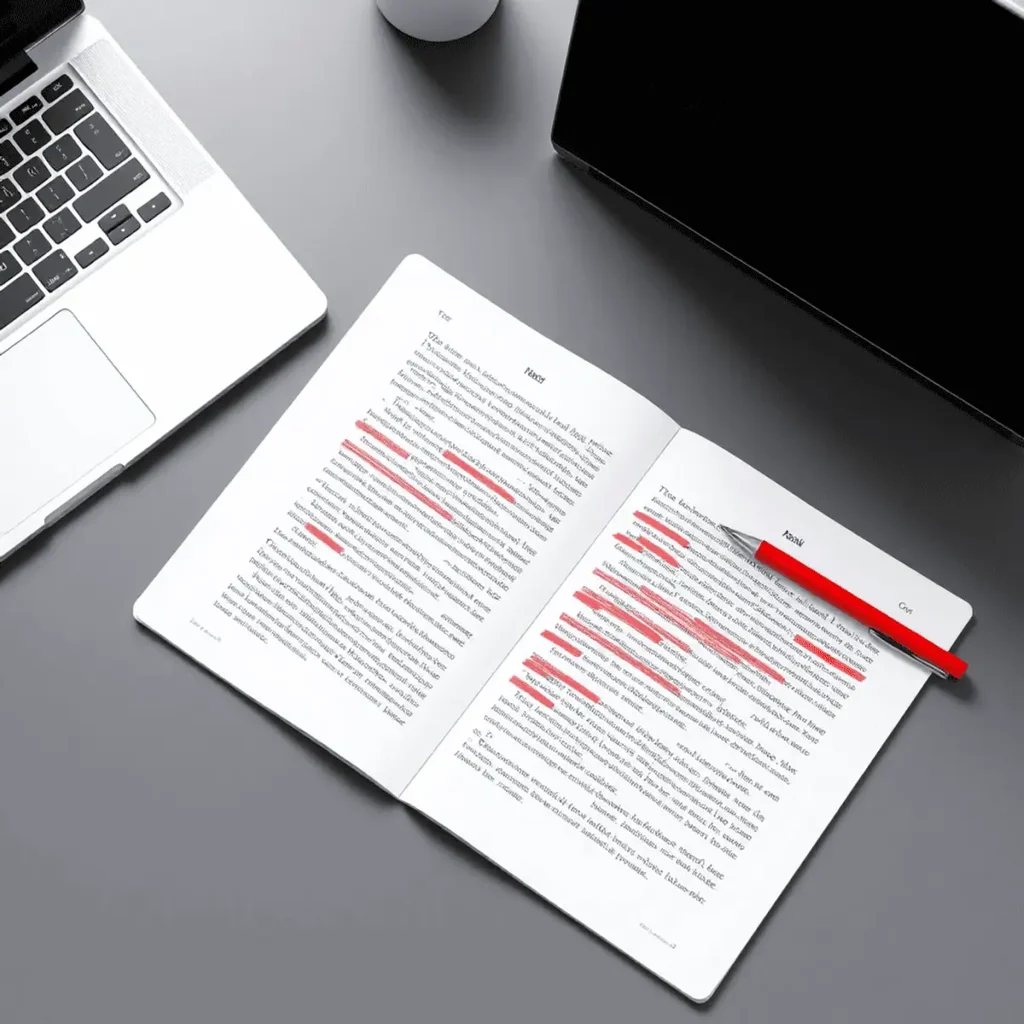As a writer, I’ve learned how vital copyediting is in publishing. It’s about checking and fixing written work to make it clear and right.
In 2025, the need for good copy editors will keep growing. This is because quality content is key in many fields. If you’re thinking about becoming a copyeditor, sites like Write Remotely can help. We show the newest copyediting jobs and keep you in the loop with trends.
Key Takeaways
- Copyediting is a key part of publishing, making sure content is accurate and easy to understand.
- The need for skilled copyeditors is increasing, thanks to the importance of quality content.
- Places like Write Remotely offer chances for those wanting to be copyeditors.
- Knowing about copyediting is important for writers, editors, and anyone who creates content.
- Copyediting means checking and improving written work to make it smooth and clear.

Understanding What is Copyediting in 2025
Copyediting is a key part of making content clear and easy to read. It’s important for marketing, education, and communication. As content grows, so does the need for good copyediting.
The Definition and Purpose of Copyediting
Copyediting means checking and improving written content. It makes sure the content is accurate, clear, and follows a style. This makes the content better for the people reading it.
- Core Functions of a Copyeditor
A copyeditor’s main jobs are fixing grammar mistakes, making sentences better, and keeping style and tone consistent. These steps help keep the content trustworthy and professional.
- The Evolution of Copyediting in the Digital Age
The digital world has changed copyediting, with new tools making it easier. But, the basic ideas of copyediting stay the same. It’s all about using your brain to check and improve content.
How Copyediting Differs from Proofreading and Other Editorial Services
Many people mix up copyediting and proofreading. But they’re not the same. Proofreading is about catching small mistakes, while copyediting looks at the big picture, like structure and tone.
- Comparing Editorial Roles and Responsibilities
There are different roles in editing, like copyediting for content improvement and proofreading for error fixing. Knowing the difference helps pick the right service for your needs.
- When to Use Each Type of Editing Service
Choosing between copyediting and proofreading depends on the content’s stage. For more on copyediting services and to find the latest jobs, check out Write Remotely.
The Importance of Copyediting in Professional Writing
As a writer, I’ve learned that copyediting is essential. It enhances the content, making it more engaging and reliable for the audience.
Why Quality Content Requires Professional Copyediting
Professional copyediting keeps content top-notch. It checks the text for mistakes, makes it clearer, and improves how it flows.
- Maintaining Brand Credibility Through Error-Free Content
Error-free content is vital for brand trust. A small mistake can hurt the writer’s and brand’s reputation. So, it’s important to check content carefully.
- How Copyediting Enhances Readability and Engagement
Copyediting does more than fix errors. It makes content easier to read. By tweaking sentences and words, it keeps readers hooked.
The Impact of Poor Editing on Reader Perception
Bad editing can harm how readers see a brand. It’s key to use professional copyediting to keep content error-free and engaging. For those wanting to be copyeditors, sites like Write Remotely offer great chances.
The Complete Copyediting Process Explained
To make writing clear and error-free, understanding the copyediting process is key. It’s a detailed method that improves written content. This makes it clearer, more coherent, and of higher quality.
Step-by-Step Breakdown of a Professional Copyediting Workflow
A professional copyediting workflow involves several steps. It ensures content is thoroughly checked and accurate. Here are the main stages.
- First Pass: Content and Structure Review
The first step is to review the content’s structure and flow. It checks if the organization, tone, and style match the audience and purpose.
- Second Pass: Language and Style Refinement
The second step refines the language. It corrects grammar, punctuation, and syntax. It also follows a consistent style guide for uniformity.
- Final Pass: Polishing and Quality Assurance
The final step polishes the content. It checks for errors and verifies facts. This stage is key for top-quality output.
Tools and Resources for Effective Copyediting
Effective copyediting uses various tools and resources. These include software, style guides, and reference materials. They help in the editing process.
- Essential Software for Modern Copyeditors
Modern copyeditors use software tools to improve their workflow. Tools like Grammarly and Trello are essential.
- Style Guides and Reference Materials
Style guides, like the Chicago Manual of Style, offer important guidance. Dictionaries and thesauruses are also valuable resources.
| Tool/Type | Description | Example |
| Software | Grammar and spell checkers | Grammarly |
| Style Guides | Formatting and style references | Chicago Manual of Style |
| Reference Materials | Dictionaries and thesauruses | Merriam-Webster Dictionary |
If you’re interested in copyediting or need professional services, check out Write Remotely. It offers valuable insights and opportunities.
Essential Copyediting Skills Every Editor Should Master
Being a copyeditor is a complex job. It requires both technical and soft skills to produce top-notch content. Copyeditors need to excel in both areas to do well.
Technical Skills: Grammar, Punctuation, and Style
Technical skills are the foundation of copyediting. Knowing grammar, punctuation, and style guides well is key.
- Mastering Grammar Rules and Common Exceptions
It’s important to understand grammar’s fine points, including exceptions. Keeping up with style guides is also essential.
- Understanding Style Guide Applications
Various publications and brands follow different style guides (like AP, Chicago, MLA). Knowing how to use these guides correctly is critical.
Soft Skills: Attention to Detail, Communication, and Time Management
Soft skills are just as important as technical ones for a copyeditor. These include attention to detail, good communication, and managing time well.
- Developing a Copyeditor’s Eye for Detail
A sharp eye for detail helps catch errors others might overlook. This ensures the final product is polished and professional.
- Communicating Effectively with Writers and Clients
Clear and respectful communication is vital. It helps manage expectations and deliver content that meets clients’ needs. For those looking to improve their skills or find copyediting jobs, Write Remotely is a great resource.
Advanced Copyediting Techniques for Different Content Types
Copyediting isn’t a one-size-fits-all job. It needs to be flexible for different types of content. As content changes, knowing how to edit for various formats and industries is key. This ensures high-quality, engaging content.
Copyediting for Digital Content vs. Print Materials
Editing digital content is different from editing print materials. Digital content needs to consider SEO, while print focuses on layout and visuals.
- SEO Considerations in Digital Copyediting
In digital content, SEO optimization is essential. This means using the right keywords, writing meta descriptions, and optimizing header tags.
- Format-Specific Editing Requirements
Different digital formats need different editing styles. For example, social media needs short, catchy content. Blog posts can be longer and more detailed.
Industry-Specific Copyediting Considerations
Each industry has its own editing needs. For instance, academic and technical writing need precision and strict style guides.
- Academic and Technical Copyediting
Editing academic and technical content requires a deep understanding of complex terms. It also needs to keep the right tone and style for the field.
- Marketing and Creative Content Copyediting
Marketing and creative content need a flexible approach. They focus on tone, brand voice, and engaging the audience.
| Content Type | Key Considerations | Editing Focus |
| Digital Content | SEO, keyword density, meta tags | Search engine ranking, readability |
| Print Materials | Layout, visual elements, tone | Visual appeal, clarity |
| Academic/Technical | Precision, terminology, style guides | Accuracy, consistency |
| Marketing/Creative | Tone, brand voice, audience engagement | Engagement, brand consistency |
If you’re interested in copyediting jobs or want to learn more, check out Write Remotely. It offers valuable insights and opportunities.
Copyediting Services: What to Expect and How to Choose
The world of copyediting services is complex. There are many options to fit different needs. It’s key to understand these services to make good choices for your content.
Types of Copyediting Services Available
Copyediting services vary in scope and intensity. They fall into different levels and specialized services.
- Light, Medium, and Heavy Copyediting Explained
Copyediting can range from light to heavy. Light copyediting includes basic corrections. On the other hand, heavy copyediting reviews structure and content deeply.
- Specialized Copyediting Services
Some copyeditors focus on specific industries or content types. These specialized services meet unique needs and requirements.
How to Select the Right Copyeditor for Your Project
Choosing the right copyeditor involves several factors. Consider their expertise and your project’s specific needs.
- Questions to Ask Before Hiring a Copyeditor
Before hiring, ask about their experience and services. Also, check their turnaround times to see if they meet your project’s needs.
- Red Flags to Watch For When Reviewing Services
Watch out for copy editors with poor communication or unrealistic promises. Also, be wary of those who lack transparency about their processes.
For the latest copy editing jobs, visit Write Remotely. For more information, explore their blog section.
Copyediting Jobs: Career Opportunities and Growth
The need for quality content is growing fast. This means more jobs for skilled copy editors in many industries.
The Current Job Market for Copyeditors
The job market for copy editors is wide open. You can find work in traditional publishing and digital media. There are jobs in book publishing and online content creation.
- In-House vs. Freelance Copyediting Opportunities
Copyeditors can choose between in-house and freelance jobs. In-house jobs offer stability and benefits. Freelance work gives you flexibility and the chance to work with different clients.
- Salary Expectations and Growth
Salaries for copy editors depend on experience and location. But, with more digital content, there’s a lot of room for growth in professional copyediting roles.
Finding Quality Copyediting Jobs at Write Remotely
Write Remotely has many copyediting jobs and copyediting services opportunities. To stand out, make a great profile and learn how to use job boards well.
- How to Create a Standout Copy Editor Profile
A great copy editor profile shows off your skills, experience, and portfolio. It’s key to grab the attention of clients or employers in the competitive copyediting field.
- Navigating Write Remotely’s Job Board
To find good copyediting jobs, use the Write Remotely’s job board wisely. Look for jobs by using specific keywords and filters to find the best matches.
Conclusion: The Enduring Value of Quality Copyediting
Understanding what is copyediting and its importance is key for top-notch writing. We’ve looked into its definition, purpose, and how it differs from proofreading. We also discussed the skills needed to be great at it.
Copyediting makes content better by ensuring it’s clear, easy to follow, and flows well. It helps writers and creators make their work more interesting and effective. This is thanks to the careful application of copyediting principles.
If you’re looking to start a career in copyediting, Write Remotely is a great place to find jobs. Their blogs section also has useful tips and insights into the field.
In short, quality copyediting greatly improves how readers see content and its success. By focusing on copyediting, everyone can make their writing better. This helps them reach their communication goals more effectively.
FAQ
What is the primary role of a copyeditor?
A copyeditor’s main job is to check and improve written content. They make sure it’s accurate, clear, and engaging. They also follow a specific style guide or brand voice.
How does copyediting differ from proofreading?
Copyediting looks at the content’s structure, tone, and style. Proofreading is the last step to catch grammar, punctuation, and spelling mistakes.
What are the different levels of copyediting services?
Copyediting services vary from light to heavy. Light editing makes small changes. Heavy editing involves a detailed review and rewriting of the content.
What skills are essential for a copyeditor to master?
A copyeditor needs technical skills like grammar and style. They also need soft skills like attention to detail and effective communication.
How does copyediting impact the quality of content?
Copyediting makes content better by removing errors and making it clear and engaging. This boosts brand credibility and reader satisfaction.
What tools and resources do copy editors commonly use?
Copyeditors use tools like grammar checkers and style guides. They also use reference materials to ensure their work is consistent and accurate.
How can I find copyediting jobs?
Look for copyediting jobs on job boards like Write Remotely. Create a professional profile and network with other professionals in the field.
What is the importance of style guides in copyediting?
Style guides help maintain consistency in writing and formatting. This is key for keeping a brand’s identity and credibility strong.
Can copyediting improve the readability of content?
Yes, copyediting can make content easier to read. It simplifies sentences, clarifies unclear text, and improves the narrative flow.
What are the benefits of hiring a professional copy editor?
Hiring a professional copy editor ensures your content is polished and error-free. This can boost your brand’s credibility and engage readers better.


 Owner of Write Remotely. Connecting businesses with talented writers and empowering remote work.
Owner of Write Remotely. Connecting businesses with talented writers and empowering remote work. 

